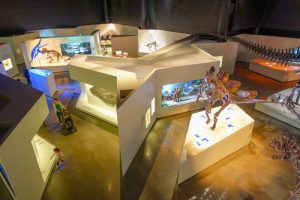The Houston Museum of Natural Science
This museum was founded in 1909, is located in Hermann Park; this museum aims to offer exciting experiences about science and education; it is one of the most visited in the United States. This building contains four floors full of science rooms. It also has a planetarium, a butterfly center, and a theater; in these facilities, you can spend all day discovering and enjoying the exhibitions that this center offers us.
You can start with the paleontology exhibition, and it is the favorite of this place since it shows us predators in action, giving the illusion that skeletal exhibits have a life of their own. There is a timeline showing the progressive design of more than 50 dinosaurs.
We continue our tour of the gem vault, it is one of the newest exhibits in this room; in this vault, we will find the most fascinating polished and cut gems and precious stones ever seen in a single exhibition. It is an exciting and entertaining experience. It includes the most delicate aquamarine in the world, the most emerald crystal in North America, and the most delicate opal stone in the world. Not to mention the dazzling diamonds, rubies, sapphires, emeralds, aquamarine, topaz, amethysts, and tourmaline.
Then we have the Salon Wiess Energy, here the application of scientific concepts and the most advanced technology in the oil and gas industries are explored. The processes of how energy is developed and how fossils are formed in alternative energy sources of the future are presented. Interactive touch screens and holographic videos project all this.
In the Hall of the Americas, she is responsible for celebrating indigenous people’s extraordinary achievements and cultural traditions of more than 50 diverse cultures from countries such as Alaska and Peru. This room is set with a magnificent museum collection. It contains feather art, carpets, ceramics, beads, dolls, gold from the pre-Columbian era, and other valuable relics from the Amazon.
Then we are transported to Africa; this room focuses on issues of ecology and the importance of conserving Africa’s wildlife with more than 120 specimens representing more than 70 species on display, including 42 species of birds and 28 species of mammals and attracting interactive videos that make this exhibition very interesting for visitors of all ages.
Now we go to the wildlife hall in Texas, which is home to various wildlife ranging from alligators, otters, mountain lions, and other animals native to the city, both in existence and extinct. It features a video screen that provides a view of the state’s seven biotic provinces, allowing all visitors to learn more about the plants, animals, and topography of these unique regions.
It also has a room on invertebrate mollusks, many of which live in shells. This animal group includes more than 100,000 species that range in size from barely visible worms to giant squid over 60 feet long.
The museum is open from Monday to Sunday from 9:00 a.m. to 5:00 p.m.; a good idea is to visit their website to check ticket prices as they usually have specific prices per area.

